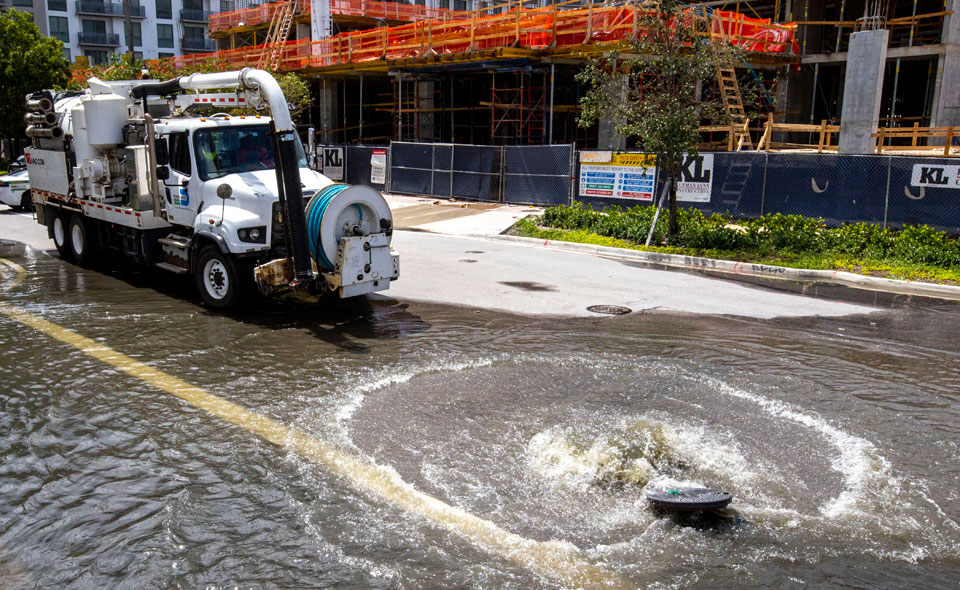
MIAMI—Escaping the throes of winter, tourists and snowbirds alike may find themselves on the beaches they seek but not necessarily under the conditions they want: Signs that read “High bacteria levels, swimming not recommended, increased risk of illness at this time” are becoming an all-too-common sight on the Florida coast.
The bacteria that the signs usually refer to are related to algae blooms like Red Tide, but another type of bacteria is also of concern: enterococcus.
There are 58 different species of enterococci known to be highly resilient as well as resistant to disinfectants. The bacteria can cause infections resulting in gastrointestinal issues, UTIs, skin infections, and, in very rare cases, meningitis.
These warning signs, however, do not seem to stop people from flocking to the oceanfront nor from swimming, snorkeling, and being in the water. In fact, poor water quality seems to occur at some beaches here weekly.
If one was curious enough to check before driving to the beach to see if the warning signs were up, they could check the Florida Healthy Beaches Program page to see the day’s current levels of bacteria. Yet even on days when water samples show high levels of enterococcus, the beaches are still packed.
Have people become too desensitized to these warnings, not letting a risk of illness get in the way of their vacation plans? Is the potential hazard simply overblown?
According to Florida’s Bureau of Environmental Health, enterococcus is naturally occurring in mammals and birds, and such spikes of the bacteria can be caused from too many seabirds defecating in the area.
There are other means by which this bacterium gets into our oceans in such high concentrations.
Earlier this year, Key West completed a $67.3 million project for a wastewater collection system and Advanced Wastewater Treatment facility. The project, originally planned for seven years, was accelerated to a three-year schedule due to the prevalence of beach health advisories warning of high levels of fecal bacteria.
Such bacteria ends up in the ocean from runoff and leaking sewage systems.
Much of Key West’s old system’s piping was made of iron, steel, and clay and dated back to the 1800s. Those pipes have all been replaced with PVC, and all septic tanks and cesspits have been removed from the island.
This is good news for residents in the lower Florida Keys who, like 25 million other Americans, had been “drinking worse water” than was found at wastewater treatment plants. Thousands of homes had not been connected to the central sewage system and leaked untreated sewage into the ground and ocean.
However, just a few hours up the road, Miami’s sewage system is making headlines for all the wrong reasons.
Back in January, raw sewage flooded the streets of North Miami, a predominantly Black and Hispanic part of town, due to pipe blockages. This came only a few short months after the last sewage backup flooded the streets of the same neighborhood.
Then in February, two wastewater pumps in Miami Beach began spilling sewage into waterways that led into Biscayne Bay. In June, heavy downpours overflowed the Miami-Dade Water and Sewer Department’s Central Plant, causing over a thousand gallons of raw sewage to spill into the Miami River. The storms of that weekend in June caused six spills throughout the area.
Key Biscayne and Virginia Key beaches were also at risk just last month when rain caused another raw sewage spill from a wastewater treatment facility. Roughly 10,000 gallons spilled into Shrimper’s Lagoon. This last spill just so happens to coincide with poor water samples due to high concentrations of enterococcus being reported throughout the Florida Keys.
Miami-Dade County still uses obsolete models for wastewater treatment, such as septic tanks and ocean outfalls, which depend more on simple dilution than treating the wastewater. Miami’s sewage infrastructure is in dire need of an overhaul, not simply for human health but also for the sake of the coral reef.
Florida’s coral reef stretches about 350 miles from Martin County—about 50 miles north of West Palm Beach—all the way down to the Dry Tortugas. Today, the reef is functionally extinct, with only 1-2% of coral coverage.
There are several factors that have led to the death of the reef—bleaching, ocean acidification, increasing water temperatures, algae blooms—but what accelerated the shrinking coral coverage was the emergence of stony coral tissue loss disease (SCTLD) in 2014.
Florida’s reef was at 6-7% coral coverage before SCTLD showed up, according to scientists with the Mote marine institute at the Elizabeth Moore International Center for Coral Reef Research & Restoration in Summerland Key.
In a handful of years, the disease was found all over the Caribbean. For a short while, the Bahamas remained untouched. That is until, at the end of 2019, it appeared there as well. The oddity is that the islands of the Bahamas are closer to Florida than the islands of the Caribbean. It is now suspected that ballast water from container ships and other commercial vessels are potentially to blame for spreading the disease.
Although what’s causing SCTLD is still unknown, studies have shown that bacteria are involved in the disease’s progression. According to the researchers at Mote, the infected coral has responded to the use of antibiotics such as amoxicillin. Related studies have found that human pathogens, often found in sewage, also play a part in coral diseases devastating reefs around the world.
One such example is Whitepox, a disease that was known for decimating coral populations in the 1990s and early 2000s and was also linked to a bacterium commonly found in human feces.
Even while there remains some uncertainty on the exact causes of such environmental hazards as stony coral tissue loss disease, it is imperative for municipalities and counties—especially those on the coasts—to begin restructuring, if not redesigning, how their cities function.
Although the effects of climate change are already so apparent, there is still time to get some things right. We know what is possible when major concerns like these are taken seriously and people come together to get to work.
Mote’s coral reef restoration project—which is bringing coral reef scientists all over the globe together to save Florida’s reef—is already an exemplary case of this. We do not need to wait until something is functionally extinct before taking such collective action.












Comments